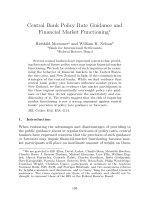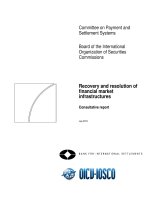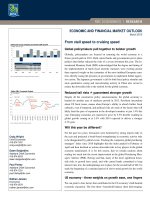BLOCKCHAIN AND FINANCIAL MARKET INNOVATION
Bạn đang xem bản rút gọn của tài liệu. Xem và tải ngay bản đầy đủ của tài liệu tại đây (731.61 KB, 13 trang )
<span class="text_page_counter">Trang 1</span><div class="page_container" data-page="1">
<b>Introduction and summary</b>
Blockchain technology is likely to be a key source of future financial market innovation. It allows for the creation of immutable records of transactions accessible by all participants in a network. A blockchain data-base is made up of a number of blocks “chained” together through a reference in each block to the previous block. Each block records one or more transactions, which are essentially changes in the listed owner of assets. New blocks are added to the existing chain through a consensus mechanism in which members of the blockchain network confirm transactions as valid. The technology allows the creation of a network that is “fully peer to peer, with no trusted third party,” such as a government agency or financial institution.<small>1</small>
While all are in the early stages of development, there are many promising applications of blockchain technology in financial markets. The bitcoin ecosystem represents the largest implementation of blockchain technology to date.<small>2</small> Interest in the technology continues to grow in the financial technology and broader financial services communities. In this article, we provide a brief overview of what blockchain technology is, how it works, and some potential applications and challenges.
<b>What is a blockchain database?</b>
A blockchain database has a network of users, each of which stores its own copy of the data, giving rise to another term for blockchain technology: distributed ledger technology (DLT). Basic elements of a DLT network are: a digital ledger, a consensus mechanism used to confirm transactions, and a network of node operators (see figure 1 for the network setup). Generally speaking, the terms DLT and blockchain are used interchangeably in position papers and popular media, though DLT is considered by some to be a more general term.
7 2017
<i>Blockchain and financial market innovation</i>
Rebecca Lewis, John McPartland, and Rajeev Ranjan
</div><span class="text_page_counter">Trang 2</span><div class="page_container" data-page="2">As one industry participant involved in developing blockchain technology described it, blockchain technology is essentially a new approach to database architecture. “Fundamentally, [it is] an improvement over the way that, traditionally, databases have been designed and used in the past.”<small>3</small> A traditional database is a large collection of data organized for rapid search and retrieval. While there are various ways of organizing data, traditionally, the vast majority of databases have been relational, storing data in tables that users can update and search.<small>4</small> Relational databases are centralized, with a master copy controlled by a central authority. Users sharing a database must trust the central authority to keep the records accurate and maintain the technological infrastructure necessary to prevent data loss from equipment failure or cyberattacks. This central authority represents a single point of failure; if the central authority fails, the database is lost. Users who do not trust one another must maintain separate databases that they periodically reconcile.
<b>How does blockchain technology work?</b>
The key elements of a blockchain-based ledger, those that will enable future efficiency gains, are the distributed nature of the ledger, its immutable character, and the existence of an agreed-upon consensus mechanism. These make it possible to automate transactions, providing for close to real-time settlement, while maintaining
<b> </b>
<sup>Source: Financial Markets Group, Federal Reserve Bank of Chicago.</sup><b>Distributed ledger (DL)–Setup</b>
<small>Operator: Each node operator is able to update his/her record in the ledger, communicate the information to the network, and reconcile his/her ledger with the other nodes in the network.</small>
<small>Consensus: Each node communicates with others to ensure consensus after an addition to the ledger.</small>
<small>Node: Each node in the DL network has an identical copy of the data.</small>
</div><span class="text_page_counter">Trang 3</span><div class="page_container" data-page="3">strong controls against fraud. These benefits do not depend on the exact technical implementation of any given blockchain—implementations will continue to be worked out in the coming years. However, a high-level overview of how a blockchain works helps to inform discussions about potential applications of blockchain and challenges that may arise.
<i><b>A simple distributed ledger </b></i>
In its simplest form, each user can read from and write to the database; and each user’s copy is updated to reflect the new state of the ledger after a transaction is confirmed through a previously agreed-upon consensus mechanism (see figure 2). Once a transaction is added, it cannot be updated or deleted.
In the example in figure 2, all the node operators have the same version of the ledger (“chicagofed0”). Since all the versions of the ledgers are the same, consensus is achieved and the records are final. When a member of a blockchain network engages in a transaction, they submit the transaction to the network (see figure 3). The submission of the new transaction changes the state of the ledger (here to “chicagofed100”), which is now in conflict with the state of other copies of the ledger. Once the new transaction is discovered by the network, the consensus breaks, forcing other operators to either validate and update their records with the latest change or reject the new addition to the ledger.
<small>Source: Financial Markets Group, Federal Reserve Bank of Chicago.</small>
<b>Distributed ledger (DL) network–All records are updated</b>
<small>Operator: Each node operator is able to update his/her record in the ledger, communicate that information to the network, and reconcile his/her ledger with the other nodes in the network.</small>
<small>This represents the current state of the ledger.</small>
<b>√</b>
</div><span class="text_page_counter">Trang 4</span><div class="page_container" data-page="4">A consensus mechanism then confirms the submitted transaction as valid. There are various methods of achieving consensus on a blockchain, as we discuss below. At this point, it is simply important to understand that a blockchain database must have a mechanism through which participants agree to a change in the state of the ledger. Once consensus is achieved, all ledgers are updated to reflect the new state (see figure 4).
<i><b>How are transactions added to a blockchain?</b></i>
At its most basic level, a transaction on a blockchain is simply a change in the registered owner of an asset. The process through which transactions are created and added to the blockchain is illustrated in figure 5.For person A to transfer an asset to person B, it is first necessary to determine if A is the rightful owner of that asset. This can be done by referencing past transactions in the blockchain and finding that, at some point, A received the asset and has not yet sold it. Once this is done, A and B can agree to the transaction (step 1). A block is created with the details of the new contract (step 2), and then A and B agree to the contract by adding their unique digital signatures (steps 3 and 4). Once both parties have signed the transaction, a cryptographic hash is calculated that will be used to link this new transaction to the chain of previous transactions (step 5). The cryptographic hash is a string of characters associated with a given block that is difficult to calculate but easy to verify. This makes it simple to verify a legitimate block, but difficult to engineer and insert into the chain a block recording illegitimate transactions.
<small>Source: Financial Markets Group, Federal Reserve Bank of Chicago.</small>
<b>Distributed ledger (DL) network–New record added and state changes</b>
<b><small>CONSENSUS</small></b>
⊗
</div><span class="text_page_counter">Trang 5</span><div class="page_container" data-page="5"><small>Source: Financial Markets Group, Federal Reserve Bank of Chicago.</small>
<b>Distributed ledger (DL) network–Reconciliation and consensus achieved</b>
<small>When all node operators agree to the change and consensus is reached, the entire network will update their own ledgers. This ensures the immutability of records for network participants and end-users.</small>
<b>Permissionless networks </b>
Blockchain technology was first used in 2009 to implement the digital currency bitcoin. The bitcoin blockchain is an example of a public network: It is open to any user who wishes to transact, and all users can see all transactions on the blockchain. The network is also permissionless: New transactions are added to the blockchain through a cryptographic consensus mechanism requiring vast amounts of computing power to confirm transactions. The chief advantage of a permissionless network is that it does not require a central authority to confirm or deny specific transactions; individuals who do not trust one another or any single central authority can transact on the permissionless network, relying on a consensus mechanism to ensure the ledger’s accuracy. This avoids the need for users to have their own database that they periodically reconcile against those of their counterparties. Instead, all transactions are recorded on a single database. Each user stores a copy of the database, so there is no single point of failure as exists with traditional relational databases. Once they are added to the blockchain transactions cannot be undone, making the ledger an immutable record of all previous transactions. Figure 6 provides an illustration of a permissionless and public blockchain network.
</div><span class="text_page_counter">Trang 6</span><div class="page_container" data-page="6"><small>Source: Financial Markets Group, Federal Reserve Bank of Chicago.</small>
<b>Blockchain (DL) network–Stylized example of a transaction</b>
<b><small>1. Person A (holder of the asset/seller) and </small></b>
<small>person B (buyer) agree on a transaction.</small>
<b><small>4. Person B’s </small></b>
<small>agreement to the new contract and transaction is finalized by B’s digital signature.</small>
<b><small>5. A cryptographic hash (like the </small></b>
<small>barcode transaction 3) is calculated based on: • Contract details;</small>
<small> • Signatures of persons A and B; • Previous block (transaction 2). </small>
<small>The hash is used to link the new block to the last block in the chain.</small>
<b><small>6. Once the consensus </small></b>
<small>mechanism agrees to the changes, the new block is added to the previous chain of blocks.</small>
<i><small>This blockchain network can be accessed by anyone in the network.</small></i>
</div><span class="text_page_counter">Trang 7</span><div class="page_container" data-page="7"><small>Source: Financial Markets Group, Federal Reserve Bank of Chicago.</small>
<b>Permissionless/public blockchain network</b>
<small>CONSENSUSDecentralized consensus authority</small>
In permissioned blockchains, it is also possible to put controls in place to allow varying levels of access to the information in the ledger. For example, regulators could be allowed to view all the details of a transaction
</div><span class="text_page_counter">Trang 8</span><div class="page_container" data-page="8"><small>Source: Financial Markets Group, Federal Reserve Bank of Chicago.</small>
<b>Permissioned/private blockchain network</b>
<small>Participants in the blockchain</small>
in the ledger but not add any transactions, while users might be allowed to view selective details of the transactions depending on their access level (see figure 8).
<b>Consensus mechanism</b>
All blockchains have a consensus mechanism that is used to add new blocks to the database. The consensus mechanism will differ depending upon the design of the blockchain, especially whether the blockchain is permissioned or permissionless. If the blockchain is permissioned, the degree to which participants in the network are willing to trust one another also has an effect on the consensus mechanism. In a permissioned blockchain, once the transaction is submitted by the two parties involved, it would then be confirmed by a permissioning member of the blockchain or by some cryptographic consensus mechanism accessible only by permissioning members. Trust in transactions is maintained because users trust the network member(s) with the power to confirm transactions.
</div><span class="text_page_counter">Trang 9</span><div class="page_container" data-page="9">Permissionless blockchains rely on their network of participants to confirm transactions, using a variety of algorithms to ensure the validity of transactions. One implementation of a permissionless blockchain, the bitcoin blockchain, uses a Proof of Work consensus mechanism. On the bitcoin blockchain, individuals known as miners compile submitted transactions into blocks. They confirm that those spending bitcoins in each transaction received those bitcoins from some earlier transaction recorded on the blockchain and race to solve a difficult computer problem; the first miner to solve the problem confirms their block and adds it to the blockchain. The miner is awarded a certain number of bitcoins in return. Because every user on the blockchain has access to the entire ledger, users can confirm for themselves that the latest block of transactions added to the chain records valid transactions, that is, that the users spending bitcoins in the latest round of transactions received them in some earlier transaction and have not yet spent them.
<small>Source: Financial Markets Group, Federal Reserve Bank of Chicago.</small>
<b>Ledger properties</b>
<small>In this example, buyer X buys 100 shares of a company ABC from seller Y at $10 per share and records the transaction on a distributed ledger. </small>
<small>The ledger has some elements that are public and can be viewed by all with access to the ledger. Other elements are private; only some users (such as the regulator) have access to those elements.</small>
<small>Sale of ABC shares: • </small><b><small>Buyer – X </small></b>
<small> X’s account info. • </small><b><small>Seller – Y </small></b>
<small> Y’s account info. • 100 shares • At $10/share • On 11/21/2016 • At 2:45:05 P.M. </small>
<small>End-user—public</small>
</div><span class="text_page_counter">Trang 10</span><div class="page_container" data-page="10">the ledger—once a transaction is added to the blockchain, all ledgers reflect this change. There is no need for further post-trade reconciliation. The way in which blocks are added to the ledger also creates an es-sentially immutable database. Since blocks of transactions are chained together, the older the transaction is, the more difficult it becomes to fraudulently change it. To fraudulently change a block, an actor would have to replace that block with a new block and regenerate all of the subsequent blocks in the chain. The consensus mechanisms ensure that regenerating blocks is difficult, either due to the oversight of permis-sioning members or to the time and energy required to create a block (in a permissionless system). The farther back in the chain a block is, the more difficult a change becomes because the number of blocks that an actor would have to regenerate increases. Thus, network members’ confidence that a transaction will never be changed increases as the number of transactions following it increases.
<b>Blockchain’s applications, benefits, and challenges</b>
Blockchain technology has the potential to provide large efficiency gains in businesses that currently require costly intermediation, including financial services. However, any implementation will also face a number of challenges. Regulators and policymakers, including the Committee on Payments and Market Infrastructures, are currently looking into both the potential applications of blockchain technology and the challenges that may arise.<small>6</small>
<i><b>Applications and benefits</b></i>
<i>Possible applications of blockchain technology include:</i>
<i>Digital assets—Physical assets (real estate, stock certificates, gold, etc.) require a great deal of verification </i>
and examination every time they are traded, which prolongs the transaction and settlement time for each trade. DLT has the potential to transform the physical assets into a digital form for transactional and record-keeping purposes. Such digitized assets could essentially function as online financial instruments that change hands each time the owner of the asset recorded in a ledger changes.
<i>Digital currencies—We are already in the era of online banking, payments, and transactions, all of which </i>
are carried out with little use of physical currencies. In recent years, various forms of cryptocurrencies have been adopted for real-world transactions. Cryptocurrencies rely on encryption techniques to generate, transact, and verify their value. They operate independently of a central bank’s authority and are not backed by the central bank. Some central banks around the world (for example, China, the UK, South Africa, and the Netherlands) are experimenting with issuing digital state-sponsored fiat currencies backed by the central government.
<i>Digital record keeping—One of the key benefits of blockchain is that it keeps an audit trail of each and every </i>
transaction and the details of the parties involved. If designed and executed well, blockchain databases will create records that are standardized, immutable, and easy for interested parties to query.
<i>Smart contracts—In order to achieve their full potential, implementations of blockchain technology will </i>
likely be accompanied by smart contracts. Smart contracts are legal contracts written in computer code that execute automatically once certain conditions, specified in the contract, are fulfilled. Smart contracts can be added to distributed ledgers to self-execute on the basis of information in the ledger. This will allow for the automation of processes that currently require manual interventions.
</div>








